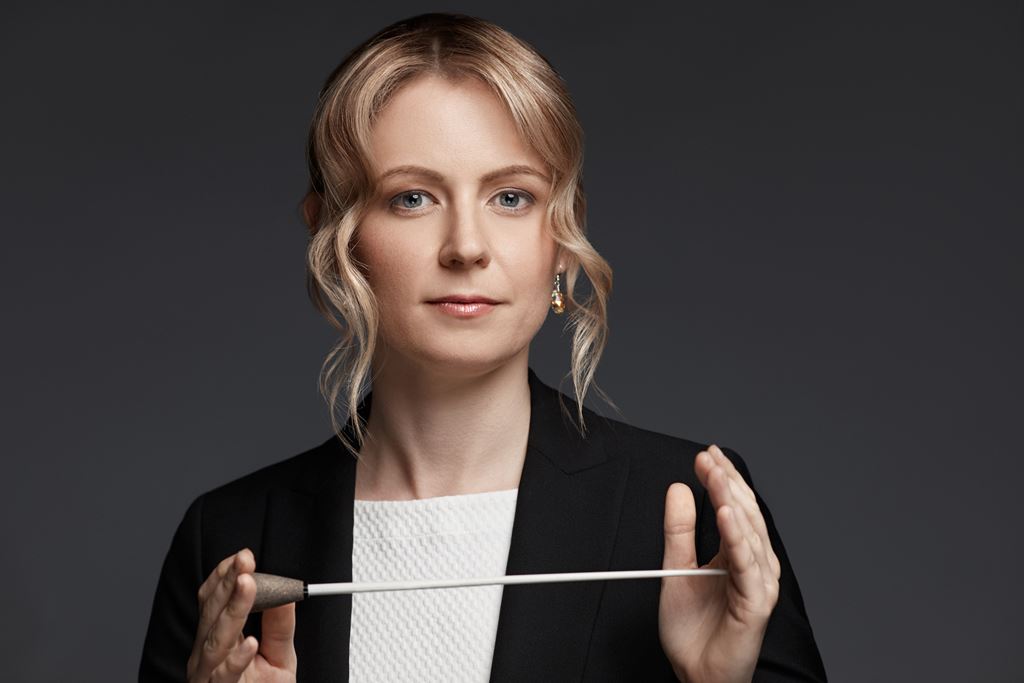The opening work on this weekend’s concerts is Rainphase, which is appropriate to its composer Salina Fisher’s Christchurch, New Zealand roots. In New Zealand rain makes Seattle a sympathetic if unofficial sister city. Composer Fisher has recreated the rainscape of Christchurch for an augmented Seattle Symphony. The rainmaker in charge for the preview concert/open rehearsal I attended is Gemma New, the artistic advisor and principal conductor of the New Zealand Symphony.
New commanded the forces on stage with authority and expansive technique appropriate to the size and sounds of her forces, from gentle raindrops to wild thrashing storms. The percussion section alone was a chamber orchestra of its own producing sounds I have never before heard from musicians. At one point, sitting in the middle of the hall I kept looking up at the Benaroya ceiling expecting to see rain coming down.
I finally traced the uncannily accurate rain sound to one of the four percussionists who was stroking two limp looking blankets with a pair of paddles that produced the rain sound. His contribution was a solo sequence that was a cadenza of its own. Like all gently streaming water, it was a calming contrast to other sections of Rainphase that all but blew the roof off the hall.
Gemma New has gone well beyond her native land and is now on the worldwide circuit of young conductors. She has the Los Angeles and Chicago, Dallas and Montreal Symphonies in her portfolio, as well as the French National Orchestra, Sweden’s Malmo, and Germany’s Bamberger Symphonies. Seattle has seen the last three years filled with guest conductors. I can well imagine this morning’s guest as a new resident Musical Director.
The first half of the concert this weekend (4/25, 27, 28) concludes with more water inspired composition, this time Benjamin Britten’s Four Sea Interludes from Peter Grimes which in full form is an opera. The musical interludes evoke a slow and tranquil opening into a spirited (allegro) “Sunday Morning,” followed by a musical moonlight andante, ending in a presto “Storm” that should have the audience standing and applauding.
The second half of this weekend’s concerts performs Ralph Vaughn Williams Antarctica Symphony (Symphony #7). This is another full-throated work that continues a stage full of the augmented Seattle Symphony while adding a narrator, a soprano solo, upper range voices of the Symphony Chorale, and the photography that is all that is left from the disastrous race of Robert Falcon Scott’s expedition to the South Pole. This is high art melodrama, musically and visually. Herbert Pointing’s photography survived to document this monument to British miscalculation, less tragedy than a misguided stiff upper lip voyage to tragedy.
Musically Ralph Vaughn Williams not only embraced the challenge of movie music which began when he wrote scores for documentaries in the 1930s, this symphony is the score for the 1948 film that chronicled Scott’s fatal race to the pole. Ralph Vaughn Williams augmented the film of the Scott disaster with what the program notes describe as: “An arsenal of percussion instruments….bells, glockenspiel, xylophone, vibraphone, and a wind machine.”
The acoustics in Benaroya Hall are made for the big sounds of this weekend’s concerts, and the giant screen will fill an audience with the madness of exploratory overreach and its fatal consequences. (Meantime the forecast calls for a roughly 50% chance of rain all weekend long.)
Discover more from Post Alley
Subscribe to get the latest posts sent to your email.

I have a suggestion to move toward a permanent music director for the Seattle Symphony. Appoint a principal guest conductor for a year, and see how well that person does in rehearsals, programming, performances, hiring musicians, board relations, getting along with the managing director, public relations, and fundraising. If the conductor succeeds, promote him or her to music director; if not, keep them on as principal guest conductor.